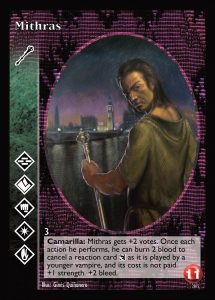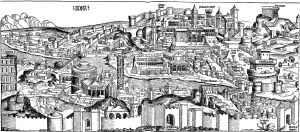I recently returned from New Orleans and the Grand Masquerade with my writing and development batteries rejuvenated! Though I’m busy working on the stretch goals for Beckett’s Jyhad Diary (about to tackle The Way of Three Eyes), I thought I would stop by and talk a little about the upcoming V20 Dark Ages Companion.
The V20 Dark Ages Companion is currently at Art Direction stage. Writers have written, our editor has edited, and for the time being, I’ve developed all that I can. With that in mind, a subject I wanted to discuss with you is one of domains.
City sourcebooks are a type of supplement I routinely get asked about. In the last month alone I’ve had several enquiries about an update to Chicago by Night for Masquerade. Since V20 Dark Ages’ release, I’ve received many enquiring messages about a potential Dark Ages atlas, an update for Constantinople or Jerusalem by Night, or something more broad along the lines of Iberia by Night. I love many of those by Night books for the ideas they gave me for my chronicles, the characters I pulled for my own stories, and the setting information I could transpose with ease.
Something I want to achieve with V20 Dark Ages Companion is the provision of multiple domains, all filled with evocative themes, moods, characters, and plots. I want this to be the go-to book for a new group looking to play in the Dark Ages for the first time, as the Storyteller will be able to flick open the book to any of the first six chapters and discover a domain for exploration in a chronicle. Which domains do we cover in the Companion? Allow me to copy in our table of contents:
Chapter One: The Domain of Rome – This chapter introduces the magnificent domain of Rome, fallen to the tyranny of Prince Camilla. The chapter concludes with apocrypha for Clans Nosferatu and Brujah.
Chapter Two: The Domain of Bath – This chapter offers coverage for the small peace town of Bath, as it struggles to cope with an influx of hopeful Cainites seeking sanctuary. The chapter contains the sinister black dog as a folklore antagonist, and apocrypha for Clans Cappadocian and Ventrue.
Chapter Three: The Domain of Bjarkarey – This chapter introduces the isolated island domain of Bjarkarey, off the coast of Norway, as its savage Gangrel ruler seeks to reap the blood of all who oppose her reign. The chapter contains statistics for the fossegrim, an enemy to Cainite and mortal alike, and apocrypha for Clans Gangrel and Malkavian.
Chapter Four: The Domain of Constantinople – This chapter reintroduces the metropolis of Constantinople, in the wake of a Methuselah’s failed ambition to make it a vampire utopia. The chapter also introduces the goblinoid kallikantzaroi, and apocrypha for Clans Lasombra, Toreador, and Tzimisce.
Chapter Five: The Domain of Mogadishu – This chapter covers the East African domain of Mogadishu, as its Cainite rulers vie for power over the split city and use faith as a weapon. The chapter contains apocrypha for Clan Assamite and the Ramanga.
Chapter Six: The Domain of Mangaluru – This chapter introduces the bustling domain of Mangaluru on India’s west coast, as it struggles to resist the War of Princes and the fall of Clan Salubri. The flesh-eating pishacha are profiled within, and Clans Salubri and Ravnos receive apocrypha.
–
As you can see, we range far and wide between domains. I want players to want to explore this Dark Ages World of Darkness and feel the difference between the horrors of Mangaluru, and the terrors of Bjarkarey. I want Storytellers to explore the fundamental differences between the Ventrue Prince of Rome and the Ventrue Consul of Bath. I want characters to get embroiled in the mania of Constantinople, and embark on a pilgrimage from that mighty city to the contested domain of Mogadishu. What myself and the writers have attempted to achieve with this book is to make each of the domains completely different in flavour.
Here are the Theme and Mood guidelines for each from the book’s introduction:
–
In Rome the Church is strong, yet the Prince is one of the greatest sinners alive. The domain’s theme is one of fallen greatness, with its ruler driving it as far beneath holiness as he is able, unless stopped. The domain is afflicted with the mood of grandeur, despite its obvious faults, its Cainites proud and willingly oblivious to their Prince’s unmitigated evil.
The theme in the domain of Bath is one of blood loyalty to an historic ideal, one that may no longer hold true. As the Consul bonds his domain’s populace and ensures their loyalty to the god emperor Mithras, he suffers a crisis of faith, leaving the utopia of Bath on the edge of civil war. The mood is desperation, as increasing numbers of Cainites flock to its walls in search of a sanctuary that may soon collapse.
Bjarkarey represents the theme of savagery, as its Gangrel ruler leads frequent raids on neighboring Scandinavian domains, and pursues crusades whenever the desire for blood takes her. The vampires of Bjarkarey must embrace violence to survive in this arduous, small domain. Yet, the mood of Bjarkarey is one of isolation. No hope will reach the distant island of Bjarkarey, forcing it into a perpetual cycle of bloodshed.
The theme in Constantinople is one of faith, as its Cainites strive to believe in something greater than their own petty politicking, and attempt to move on from the failure of a Methuselah’s shattered dream. As the world’s greatest metropolis fractures under the weight of repeated crusades, the domain exudes the mood of hopeful expectation. Its vampires are determined to reject failure, and embrace greatness once more.
Mogadishu’s theme is shadow war, as rival tyrants don masks of piety to claim the greatest domain on East Africa’s coast, and find the faith working against them. Arrayed against the Clans and bloodlines roving the bazaars and alleys are hidden forces and an ancient monster, who on a whim could destroy all that Mogadishu’s usurpers hope to build. The domain’s mood is sweltering tension, as opportunities in Mogadishu abound, but the hot-blooded Cainites within violently compete for the richest treasures.
In Mangaluru, the theme is that of resolve, and the old ways inexorably passing into the new. In this domain, the Long Night never ended. Old alliances hold firm, and new bloodlines find the seizing of power difficult. Yet, the mood is amor fati. The domain’s millennia-old hierarchy is on a path to destruction – their fate – and they cannot help but embrace it.
–
There is even more besides exploration of domains in the V20 Dark Ages Companion, including a further two chapters that I’ll aim to tease in a future blog post. In the meantime, I would like you to comment regarding the domain and apocrypha you’d like to see teased the most. You’ll be seeing me again very soon…
Oh, and here’s a portion of the Ventrue Apocrypha before I go:
–
To my blood elder Cretheus, First Senator of Rome
It is with humility I write, and trust this letter reaches you seal unbroken. The messenger is a most honored Leo. Please return her unharmed.
Not long after my Embrace, my sire remarked our line is one of titans. I retorted that surely all Ventrue must be gods, foolishly believing flattery might endear him. For the affront, I became subject to his chastisement. As thrall, he forced me to humiliation and education. He willed it so, and I learned. After five decades in slavery, he took me in arms once more. The titans fought the gods, said he. Those who call themselves Ventrue fight their masters. We fight gods, and wrest power from their grasp. There is only one god worthy of the titans’ worship, and he is Mithras.
Until now, our Clan’s pact of titans against gods remained in place despite Arakur’s chaos. The new wars between our lineages imply an awakening. The gods rise. Antasians battle the Gaul’s dreamers. We war with Alexander’s Triumvirate. The rival lineages of Tinia, Artemis Orthia, and Medon grow in strength. We believed Hardestadt free, but activity within the Fiefdoms of the Black Cross implies the influence of his sire, who we believed destroyed. Our power was through unification. I fear the Clan is provoked to war from beyond.
Mithras gives guidance. He commands all must look to him, if we are to survive his fellow gods’ wrath. We must protect the titans from themselves, and force the gods into the Unconquered Sun’s light. It is the path with which I tutor the loyal Praetorians, and it is how I urge you to stabilize Rome before Camillus places it in Veddartha’s grip. Mithras sees the master’s hand, and wishes it cut off.
We start in Rome, and in Avalon, and from there take Mithras’ word to our fellow titans. Unified under Mithras we might stave off the gods.
With sincerest respect,
Arcadius Pater, Consul of Aquae Sulis
Childe of Marcus Verus, Baron of Deva Victrix
Grand-childe of the God-Emperor Mithras, Unconquered Sun, Prince of Londinium and the Baronies of Avalon, Progenitor of our Line
Ventrue exalt in the glory of their lineage. A Ventrue in a Toreador court may bore the Queen of Love with recitation of ancestry, but that same Patrician in a Ventrue court will be expected to recount not only the names of her forebears, but their achievements and misdeeds. Woe betide the Power Monger who misremembers.
In truth, there is little to do but take many Ventrue proclamations of lineage at face value. When summoning a vampire of the Eleventh Generation to recite her great, great grand-sire’s domain name and deeds, it is more a test of the Cainite’s ability to tell a convincing tale than a memory exam. Presentation only becomes a factor when naming notable Ventrue. If a Patrician claims their sire as “Francis the Woodsman, murdered by Lupines one night following my Embrace,” few Ventrue would shift in their seats. If instead she names an ancestor such as “Titus Venturus Camillus, Prince of Rome,” the claim will draw questions, interest, and where the declarations are believed, approval and hospitality. Even rogues are acclaimed, if their legends are known.
No ancestor is as important in the Ventrue lineage as the Fourth Generation Methuselah. Each of the Fourth Generations’ lines habitually manifest certain traits, fuelling claims they possess blood more potent than other Clans. Scholars of the vitae postulate each Methuselah spawns a new bloodline, but learned Ventrue refute such speculation. “Ventrue vitae is pure and never spawns a bastard line,” they say, “but the Ventrue progenitors’ minds are strong, and leave impressions on all but the most thin of blood.”

